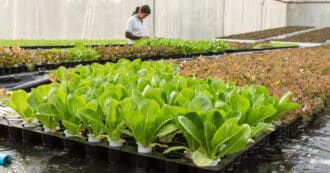By Harry Cooper
What Is The Green Revolution?
The Green Revolution was one of the greatest shifts in the process of agricultural production in the history of humankind. In the 1940s through the 1960s, new agricultural techniques and agricultural technology was developed causing a huge increase in crop production. This, in turn, caused increased food production, combatting starvation and making more food accessible to people in developing countries. However, even though on paper the Green Revolution seems like a great benefit for humanity, it does face criticism. Some argue that increasing food production does not account for an increasing population as well. Others argue that the new crops are not as nutritious. But arguably the thing most people are critical about, are the ways in which the new farming techniques brought on by the Green Revolution caused serious environmental damage.
The History & Consequences of the Green Revolution
The Green Revolution was started in the 1940s by an American agricultural scientist named Norman Borlaug. Borlaug was doing agricultural research on crops in Mexico in the 1940s. In his time there he was able to develop a variety of wheat that was disease resistant and produced a high yield. With these high yield varieties, Mexico was able to go from a wheat importing country to a wheat exporting country. Once word spread about Borlaug’s agricultural development, other places around the world started to adopt his Green Revolution techniques.
As people began to see the good that these agricultural techniques could do for the world, many people started to invest in the production of new agricultural techniques. Borlaug eventually got funding from both the Ford and Rockefeller foundation to continue his international agricultural research. Borlaug would eventually put his research to good use again in the 1960s as rapid population growth on the Indian subcontinent caused widespread famine. Similar to the wheat in Mexico, Borlaug developed high yield crop varieties of rice, that greatly increased agricultural productivity. Since the advent of these high yielding varieties, India’s famine has largely subsided, and India has even become an exporter of rice.
Green Revolution Agricultural Technology
During the Green Revolution, Borlaug developed and used a serious of technologies and modern agricultural techniques that had been invented which allowed him to create high yields of crops around the world. One of the biggest problems that farmers faced before the Green Revolution, especially in Mexico, was crippling drought. Simcha Blass developed the innovative drip irrigation system, in 1956 in Israel, that made it easier for water to get to more crops. Drip irrigation involves threading pipes throughout farms that would drip water directly onto the roots of plants. Borlaug used this technique as it was more efficient than previous methods and also required less water.
Borlaug also used genetic engineering to develop high yielding varieties of crops that provided more food than traditional varieties. These genetically engineered high yield crops were designed to grow more food, be more efficient, and be hardier against harsh weather conditions and drought. While these modified plants helped increase crops yields, they were also designed to be more receptive to chemical fertilizers and pesticides, making farmers who used them rely more on potentially dangerous substances.
One of the more controversial advents of the Green Revolution was the invention and implementation of synthetic fertilizers and pesticides. These products worked amazingly for Borlaug’s crops, helping them produce higher yields and keeping pests off of them. However, while the synthetic pesticides and fertilizers helped feed people around the world, they often contaminated soil and water and caused some serious environmental harm. The increased use of chemicals in agriculture also has a direct correlation with the increase in human cancer diagnoses. The chemicals are such that they can not be simply “washed off”, as they are absorbed into the plant itself, which is then consumed.
Mixed Results of the Green Revolution
Many sociologists have studied the extent to which increasing food production has actually helped fight hunger. The impact of the Green Revolution is often hotly debated, as some claim that it had little to no impact on increasing food security at all. Whether you believe that the Green Revolution created any benefit for the world or not, there is some evidence that the Green Revolution was, to a certain extent, a mixed success.
While the Green Revolution provided a lot more food, the food itself was not necessarily as helpful or utilized as some would expect. While the Green Revolution allowed countries to grow more food, a lot of this food was not actually going to combat hunger. Much of the food produced in the Green Revolution was exported to be used as feed for animals or to be made into biofuels.
Along with this, the kind of agriculture that the Green Revolution brought on relied heavily on monoculture crops, meaning most farms only grew one type of crop. This destroys the health of the soil which is then blown or washed away leaving farmers to grow food in almost synthetic soils. In addition, his can be very problematic, as people were eating less types of food. This means that even though they had more food overall, they weren’t getting as many nutrients to combat malnutrition and nutrient deficiencies. This problem was made even worse by Green Revolution farming methods damaging the surrounding environment. This harmed fisheries, native plants, other crops, and traditional farming methods making it even harder to find sources of nutrients other than the Green Revolution monocultures.
Environmental Impacts of the Green Revolution
There are a lot of environmental issues associated with the Green Revolution, but one of the most prominent issues with the techniques brought on by the Green Revolution was the usage of industrial fertilizers and pesticides. Pesticides are incredibly poisonous and can harm soil quality, as well as kill off local animals when the pesticides runs off into local water supplies. Not only that, but as pests grow more and more resistant to pesticides, farmers need to use increasingly more potent pesticides every year, adding more dangerous chemicals to the surrounding environment. Fertilizers also cause a great deal of harm to the environment. When it rains, fertilizers run off from farms and enter local water supplies. When this happens, the chemicals that once helped plants grow then help algae grow at unnaturally rapid rates. This quickly depletes oxygen in the water supply and kills off aquatic life through a process called eutrophication.
Another environmental impact of the Green Revolution was how much water it required farms to use. Drinkable water is already in short supply in today’s world, and part of the reason why is because of water intensive Green Revolution Farming techniques. This shortage of water due to the Green Revolution can best be seen in India, where Borlaug introduced the Green Revolution through rice cultivation. Before the Green Revolution India grew all types of crops such as lentils, millets, and even indigenous varieties of rice. However the type of genetically modified rice that the Green Revolution introduced required lots of water, extensive irrigation, and even flooding, which caused a lot of places in India to be even more stressed to find clean water in a world already facing extreme water shortages.
Techniques used in the Green Revolution have also caused a great deal of air pollution. In both pre and post Green Revolution farming, crop rotation is an important part of a healthy farm. This means that every crop cycle farmers must plant their crops in a different area as to keep the soil healthy, and the farm running efficiently. However, this becomes a problem for people using Green Revolution farming techniques. Since genetically engineered crops grow faster, they often have shorter growth cycles, meaning crops must be rotated faster. Because of this, farmers often have to burn old crops to make way for new ones. This controlled crop burning often releases green house gasses such as carbon dioxide and methane, and can cause dangerous air pollution that is harmful to humans and can contribute to global warming.
Green Revolution and Religion
Yonat Shimron’s article in Deseret News discusses advances and stalls in Christian support for the Green revolution. On the one hand, “In Protestant churches across the country, they have gone on carbon fasts, planted church vegetable gardens, and struck alliances with Native Americans and others to protect the country from the environmental harm caused by drilling, fracking, mining and building underground gas pipelines” In a similar vein, Pope Francis has been increasing environmental awareness and care through his groundbreaking work “’Laudato Si’: On Care for Our Common Home,” a 2015 encyclical on the environment.
On the other hand, a study conducted from 2005-2015 reveals that “Christians have not become more concerned about the environment, and in some cases have become less so.” Yonat theorizes about why there has been this stagnancy and in support for the environment among Christians.
Some have criticized the study itself, citing that “for many evangelicals, words in the survey like ‘climate change’ and ‘global warming’ invoke pitched political and ideological battles. They may have been more responsive when asked about environmental stewardship — or, in the more common Christian parlance, ‘creation care.'”
A Pew Research poll in 2018 found that “81 percent of Democrats say protecting the environment should be a top priority, compared with 37 percent of Republicans.” Environmentalism is highly politicized, but with sensitivity to our language we can build allies across the political spectrum.
Yonat also mentions how decreased concern for environmentalism among Christians could come from “the massive public relations campaign developed by several industries, such as tobacco, gasoline and coal-burning power plants, to sow doubt and confusion about scientific data.” This is the theory of Katharine Hayhoe, a climate scientist at Texas Tech University and an evangelical who works to convince Christians about the reality of global warming.
It is disturbing to see how billions of industry dollars can be used to convince people that climate change isn’t real, despite the fact that at least 97% of climate scientists agree to the existence of climate change. We have a religious obligation to help the green revolution continue to grow among our fellow believers, no matter the power and wealth of our opponents. In the words of God to the Prophet Zecharia, we shall triumph “not by might nor by power, but by my Spirit.” With God’s spirit on our side, we can save Creation.
* Featured image source








